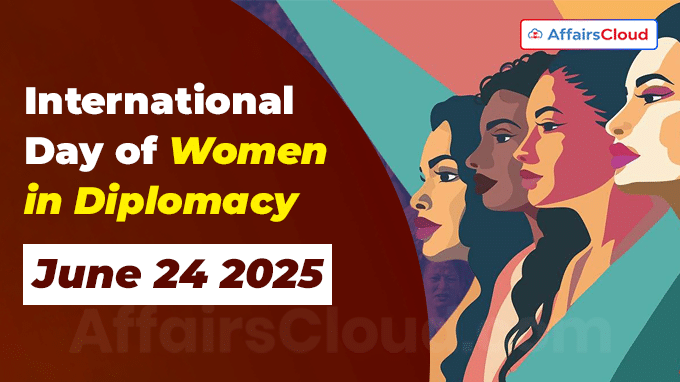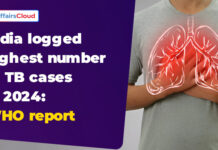 The United Nations (UN’s) International Day of Women in Diplomacy(IDWID) is observed annually on 24th June to recognise and promote the participation of women in diplomatic roles, including peacebuilding, negotiation, and multilateral diplomacy.
The United Nations (UN’s) International Day of Women in Diplomacy(IDWID) is observed annually on 24th June to recognise and promote the participation of women in diplomatic roles, including peacebuilding, negotiation, and multilateral diplomacy.
- This day recognises women’s contributions to diplomacy and calls for removing barriers to their equal role in decision-making. It supports Sustainable Development Goal (SDG) 5 – Gender Equality by highlighting their roles in peace, security, and global cooperation.
- June 24, 2025 marks the 3rd edition of the IDWID.
Theme:
i.The theme for IDWID 2025 is “Eliminating Structural Barriers to Women’s Leadership in Diplomacy”
ii.The theme highlights the need to address obstacles like gender discrimination, underrepresentation, and workplace inequality in diplomacy. It urges actions such as institutional reforms, mentoring programs, and gender-inclusive policies to empower more women in global leadership roles.
Background:
i.The day was proclaimed by the United Nations General Assembly (UNGA) on 20th June 2022 during its 76th session, through Resolution A/RES/76/269.
ii.It was first observed on 24th June 2023.
Commemorative Events 2025:
i.The 3rd annual commemorative event was held at the Trusteeship Council Chamber, UN Headquarters in New York, United States of America (USA) on 24 June 2025.
ii.It featured high-level government officials, diplomats, and UN representatives engaging in informal discussions on strengthening women’s leadership in multilateral diplomacy.
Global Representation of Women in Politics 2025:
The Inter-Parliamentary Union (IPU) and UN Women released the annual “Women in Politics” map, revealing persistent gender gaps in political representation worldwide.
- As of January 2025, women occupy less than 23% of foreign affairs ministerial and ambassadorial positions, underscoring persistent under-representation.
- India ranks 174th with 5.6% in terms of representation of women in parliaments. Nicaragua topped in the list with 64.3%.
Top 5 countries(As of January 2025):
| Rank | Country | Total Minister/Women | % women |
|---|---|---|---|
| 1 | Nicaragua | 14/9 | 64.3 |
| 2 | Finland | 18/11 | 61.1 |
| 3 | Iceland | 10/6 | 60 |
| 3 | Liechtenstein | 5/3 | 60 |
| 5 | Estonia | 12/7 | 58.3 |
| 174 | India | 36/2 | 5.6 |
Key Global Statistics:
i.Heads of State/Government: Only 25 countries (18 Heads of State, 16 Heads of Government) are led by women, including:Barbados, Iceland, India, Mexico, and Tanzania.
ii.Parliamentary Representation:Global Average: 27.2% women in single/lower houses.
iii.Regional Leaders:Americas: 35.3% (highest regional average), Europe: 31.8%, Sub-Saharan Africa: 27.1%, Asia: 22.1%, Middle East & North Africa: 18.1% (lowest).
iv.Cabinet Minister Representation:Global Share: 22.9% women.
v.Top-Performing Countries: Nicaragua (64.3%), Finland (61.1%), Iceland (60%).
vi.Portfolio Distribution:Highest: Human rights/gender equality (87%), Social affairs (71%). Lowest: Defense (14%), Foreign affairs (16%).
vii.Country-Specific Highlights: Rwanda: Leads with 63.8% women in the lower house.
- India: 13.8% women in Lok Sabha; 16.7% in Rajya Sabha.
- USA: 28.7% women in the House; 25% in Senate.
viii.Zero Representation: Oman, Yemen, and Saudi Arabia have no women cabinet ministers.
Note:
- New Zealand became the first country to grant women voting rights in 1893
- Khertek Anchimaa Toka was the world’s first elected woman head of state (1940–1944) in the former Tuvan Republic.
About UN Women:
UN Women, formally known as the United Nations Entity for Gender Equality and the Empowerment of Women, is a United Nations agency dedicated to gender equality and women’s empowerment worldwide.
Executive Director(ED) – Sima Sami Bahous
Headquarters – New York, the United States of America (USA)
Established – 2010.




